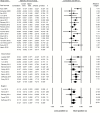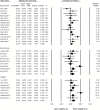Childhood Trauma Is Associated With Severity of Hallucinations and Delusions in Psychotic Disorders: A Systematic Review and Meta-Analysis
- PMID: 29301025
- PMCID: PMC6101549
- DOI: 10.1093/schbul/sbx161
Childhood Trauma Is Associated With Severity of Hallucinations and Delusions in Psychotic Disorders: A Systematic Review and Meta-Analysis
Abstract
Introduction: Childhood trauma is a risk factor for the development of psychosis. Furthermore, a number of theories propose specific mechanisms by which childhood trauma may contribute to more severe positive and negative psychotic symptoms, some of which are supported empirically. The robustness of this empirical evidence is unclear due to mixed results and methodological limitations of individual studies. A systematic review and meta-analysis of the evidence for associations between childhood trauma and severity of hallucinations, delusions, and negative psychotic symptoms in clinical populations with a diagnosed psychotic disorder is needed.
Method: A systematic search was conducted. Reference lists of relevant review articles were hand-searched, and authors contacted for data and additional unpublished studies. Study reporting bias and quality was assessed.
Results: In total, 6667 studies were identified and of these 41 studies met inclusion criteria. Of these, 29 studies (4680 participants) were meta-analyzed. Among individuals with psychosis, childhood trauma was significantly correlated with severity of hallucinations (r = .199, P < .001) and delusions (r = .172, P < .001) but contrary to our hypothesis, not correlated with severity of negative symptoms (r = .049, P = .095). Severity of childhood neglect was correlated with negative symptoms (r = .142, P = .005).
Conclusion: The results lend support for cognitive and biological theories that traumas in childhood may lead to hallucinations and delusions within psychotic disorders and have important implications for clinical practice.
Figures




References
-
- Kelleher I, Keeley H, Corcoran P, et al. . Childhood trauma and psychosis in a prospective cohort study: cause, effect, and directionality. Am J Psychiatry. 2013;170:734–741. - PubMed
-
- Trauelsen AM, Bendall S, Jansen JE, et al. . Childhood adversity specificity and dose-response effect in non-affective first-episode psychosis. Schizophr Res. 2015;165:52–59. - PubMed
Publication types
MeSH terms
LinkOut - more resources
Full Text Sources
Other Literature Sources
Medical
Miscellaneous

